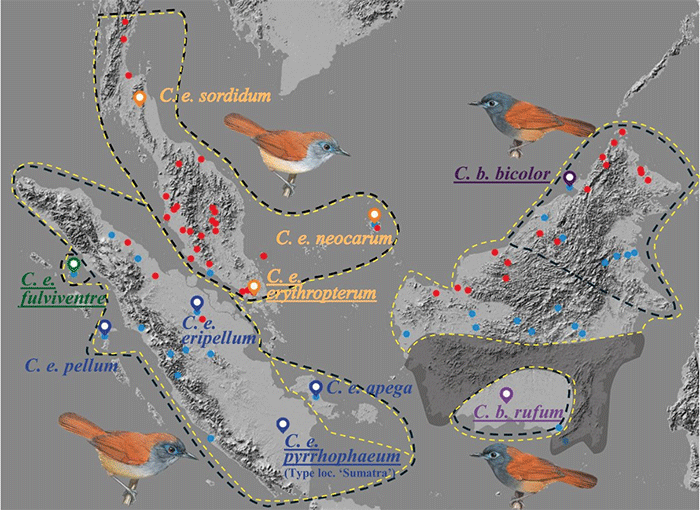Babblers, by the numbers: colour metrics tidy up a muddled subspecies map
Chestnut-winged Babbler complex reshaped: Bangka–Belitung form revived, Banyak Islands name sunk, and Borneo’s boundary pushed south

Why this matters
Subspecies decisions ripple through checklists, conservation priorities and future splits. A new, measurement-led overhaul of the Chestnut-winged Babbler complex replaces subjective ‘looks’ with repeatable colour metrics—and the taxonomy moves accordingly.
What the researchers did
Working from more than 170 museum skins across most named forms, the team photographed specimens under controlled light, extracted mantle and breast colour values, and tested diagnosability using the classic 75% subspecies rule (and a tougher 95% version). They quantified how far the chestnut mantle extends onto the crown by measuring an angle above the eye and built “colour-distance” trees with a standard colour-difference algorithm. A small vocal check helped place an awkward island taxon.
The headline changes
- Cyanoderma erythropterum apega is reinstated for Bangka and Belitung birds, which differ in crown pattern and overall mantle tone; available audio also aligns them with erythropterum rather than Borneo’s bicolor.
- fulviventre (and pellum) are synonymised under Sumatran C. e. pyrrhophaeum, with quantitative measures showing no clear separation for Banyak and Batu island birds.
- Borneo’s boundary shifts south: the crown pattern separating C. bicolor bicolor from C. b. rufum indicates a line much farther south than many field guides show, likely tracking the low, swampy Central Kalimantan landscapes.
How the colour tests worked—plainly
Instead of debating “rufous” versus “mouse-grey”, the authors turned each plumage patch into numbers, then compressed those data into a single diagnostic axis (linear discriminant analysis). Pairs that cleared the 75% rule counted as diagnosable; most did not under the stricter 95% threshold—illustrating why that bar can be too blunt for subspecies-level colour. The colour-distance trees largely agreed with the 75% outcomes and were especially helpful where sample sizes were small.
Patterns worth noting
- Breast colour carries the signal: differences among Sumatran and peninsular forms are clearest in the breast, not the mantle.
- Borneo shows a cline: within nominate bicolor, the “chestnut-to-grey” crown transition angle increases from south to north—hinting at broad, possibly sexual-selection-driven variation, with rufum as the southern extreme.
What changes for birders
- Checklists should recognise C. e. apega (Bangka–Belitung).
- Banyak and Batu records fold into C. e. pyrrhophaeum.
- Maps for C. b. rufum should shrink northwards, concentrating on southern Borneo’s lowlands; bicolor reaches farther south than widely shown.
Caveats & next steps
Some regions remain thinly sampled, and museum age can affect colours—though checks suggest only weak age effects. Broader audio coverage and fresh genomic data would tighten placements and test the Borneo cline. As a template, these colour-first, rule-based methods are scalable and transparent.
Bottom line
Put the tape measure on colour and the taxonomy tidies itself: Bangka–Belitung’s babblers stand out; Banyak/Batu birds don’t; and Borneo’s subspecies boundary sits further south. Expect updated maps, revived names—and a clearer platform for any future split talk.
Plain-speaking headline options
- Chestnut-winged Babbler shake-up: one island form back, one name gone, Borneo line redrawn
- Numbers beat eyeballing: colour metrics rewrite Babbler subspecies
- Bangka–Belitung birds revived; Banyak name dropped in Babbler tidy-up
- South Borneo, not “North vs South”: new data move the subspecies boundary
- Colour rules, cleaner taxonomy: how measurements fixed a messy Babbler map
October 2025
Get Breaking Birdnews First
To get all the latest breaking bird news as it happens, download BirdAlertPRO for a 30-day free trial – no payment details required – and access exclusive first-time subscriber offers.
Share this story







